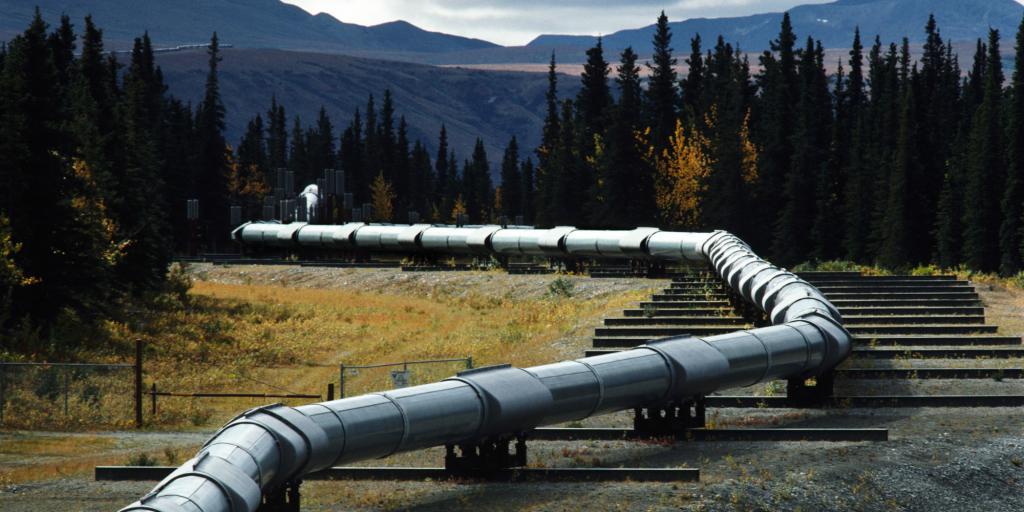Main oil pipelines and oil product pipelines are designed to transport crude oil and its refined products over long distances from the place of production (oil refinery) to the final consumer. This method is much more cost-effective than other delivery methods.
Description
The main oil pipelines are widely used in the world. They are called upon to unite in a single technological chain mineral deposits (which are often located in sparsely populated inaccessible regions) or their storage areas with processing (oil-consuming) enterprises, usually located near large industrial centers.
Their appearance is due to economic feasibility. If you want to move large volumes of "black gold", then there is no better way. Crude oil can be delivered by water, rail, and much less often by road. But each of the methods requires injection into the tank, transshipment (if required) and unloading of the product, which entails additional costs. Even more funds are spent on the purchase, maintenance of vehicles and fuel. In turn, the system of trunk pipelines avoids many costs. Pumping oil through pipes under pressure requires much less energy, and operating costs are incomparably lower.
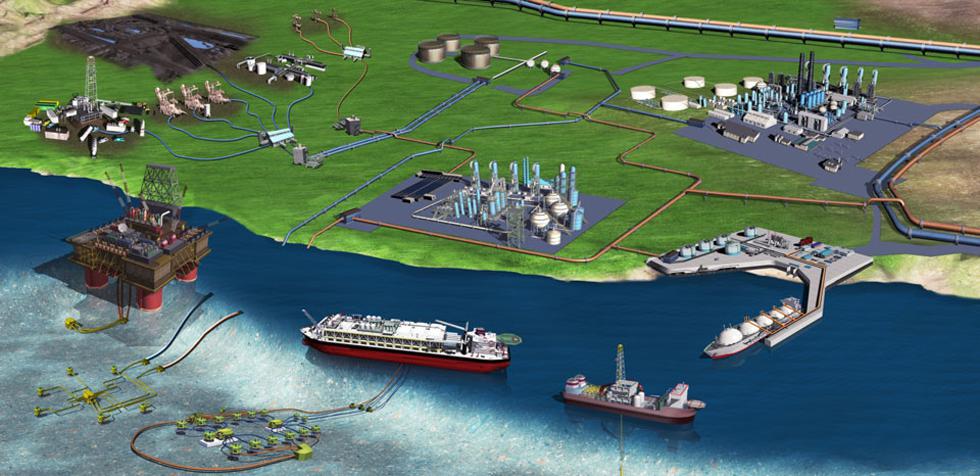
The management of oil pipelines is carried out by certified organizations that have the appropriate licenses and the necessary competencies. Their tasks include safety supervision, control of technical and technological parameters, maintenance and repair work.
Statistical data
Pipelines pass through the territories of 120 countries. Their total length exceeds 2,000,000 km. Of these, the United States accounts for about 60%, Russian trunk pipelines account for 10%, Canada 5%. Thus, these countries account for 3/4 of the pipeline systems of the planet. Over the past three years alone, plans have been voiced for laying new transport lines with a total length of 190,000 km, 50,000 of which are already under construction.
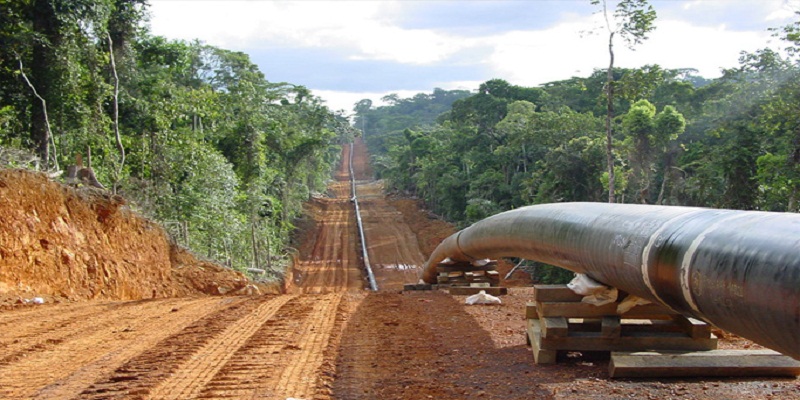
By the way, one of the longest oil arteries is the Druzhba pipeline, built in the Soviet Union. Its length is over 5,000 km. The main branch extends from the deposits of Tatarstan and the Samara region to consumers in Central Europe.
History reference
It is not known exactly who owns the idea of building an oil pipeline. Some historians call the company Branobel, others the famous Russian civil engineer Vladimir Shukhov. It is proved that in the 1860s, hydrocarbons were pumped through a 10-kilometer 51-millimeter pipeline in the state of Pennsylvania (USA).
The construction of oil trunk pipelines in our country began from the moment of mass development of hydrocarbon deposits in the 1960s. Given the remoteness of oil producing regions, difficult climatic conditions and a relatively poorly developed transport network, the government made a competent decision to deliver crude oil through large-diameter pipes connected to a single network. Fortunately, there was enough metal for their production.
For example, it is difficult to deliver hydrocarbons from Western Siberia using alternative methods. The only reliable transport artery is the Ob River with a tributary of the Irtysh, but in the winter they freeze, ice freezing lasts up to six months. The nearest railway at the time of the beginning of the development of the Siberian bowels was 700 kilometers away, and there were no paved roads at all.
The only reasonable solution was the construction of the pipeline.The first of them was put into operation on the eve of the New Year of 1966. A 400-kilometer branch connected the Shaim oil-bearing region with Tyumen, a large industrial and transport hub. As new fields were developed, the geography of the distribution of oil pipelines grew: threads from Komi, the Caucasus, the Volga region, Kazakhstan, and Azerbaijan stretched to chemical plants and distribution stations.
By the way, the “first-born” is the 144-kilometer pipeline connecting the Ozek-Suat field with Grozny. Oil was pumped through pipes with a diameter of only 325 mm, and so that it did not stagnate, it was preheated.
Africa pipelines
The main oil pipelines of the "black continent" are:
- Chad - Cameroon (East Africa): 1,070 km.
- Ecele - Sehira (Algeria, Tunisia): 790 km.
- South Sudan - Ethiopia (Northeast Africa): under construction.
- TransNET (South Africa): 3,000 km.
- Suez Mediterranean (Egypt): 320 km.
- Tazama (East Africa): 1,710 km.
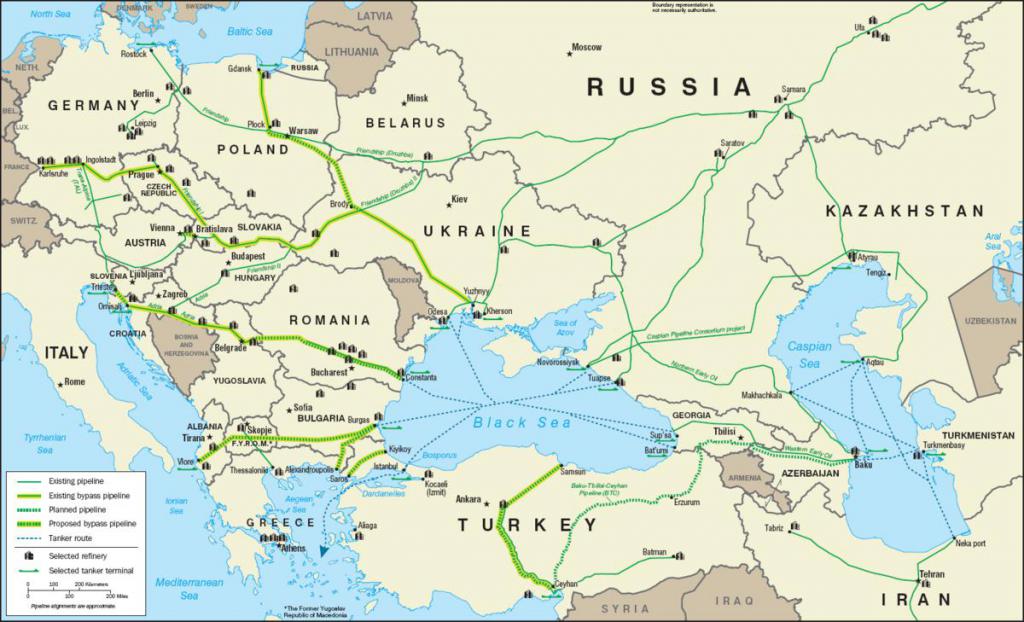
Europe
On the European continent, there are dozens of transnational pipelines and countless branches. We list the largest of them:
- Transalpine (Central Europe): 750 km.
- South European: 1 850 km.
- AMBO (Balkans): 912 km.
- Pan-European (Balkans): Presumably 1,850 km under construction.
- Odessa - Brody (Ukraine): 674 km.
- Baltic Pipeline System (Russia, Baltic States): 1,885 km (2,718 km after construction).
- Brent System (North Sea, UK): 147 km.
Asia
The richest reserves of “black gold” are concentrated in Asia. The most important main pipelines of the continent are:
- Baku - Ceyhan (Western Asia): 1,768 km.
- Baku - Supsa (Western Asia): 833 km.
- Baku - Novorossiysk (Transcaucasia): 1,330 km.
- Kazakhstan - China: 2,228 km.
- Vostochny (Russia, China): 4,740 km.
- China - Myanmar: 771 km.
- Kirkuk - Ceyhan (Iraq, Turkey): 970 km.
- Samsun - Ceyhan (Turkey): 550 km.
- Mathura - Koyali (India): 1,000 km.
- Mumbai - Manmad (India): 1,500 km.
- South-North (Korea): 900 km.
- Trans-Arabian (Arabian Peninsula): 1,200 km, one of the first oil pipelines in the world (1947), decommissioned.
- Trans-Caspian (Kazakhstan, Transcaucasia): 700 km, under construction.
- White Oil (Pakistan): 700 km.
- Habshan - Fujairah (United Arab Emirates): 360 km.
America
The American region is also rich in hydrocarbon deposits. Their greatest concentration is observed in Venezuela, Colombia, Mexico, Texas (USA), Canada, Ecuador. By the way, the United States has the most developed pipeline network in the world. And some of the longest branches are laid through the wild lands of Canada and Alaska.
- Enbridge (Canada, United States): 5,360 km.
- Redwater - Port Credit (Canada): 4,840 km.
- Keystone System (Canada, USA): 3,460 km, under construction.
- Portland - Montreal (USA, Canada): 360 km.
- Kinder Morgan Mountain (Canada): 1,150 km.
- Colonial (USA): 8,850 km, seven major accidents were recorded on the main oil pipeline connecting the Gulf of Mexico in Texas with New York.
- Big Inch and Little Big Inch (USA): 2,000 km and 2,370 km, one of the first pipelines (1942, 1943).
- Calnev (USA): 890 km.
- Dakota Access (USA): 1,880 km.
- Double H (USA): 744 km.
- Pony Express (USA): 1,220 km.
- Seaway crude system (USA): 1,100 km.
- Trans-Alaskan (USA): 1,288 km.
- New Mexico - Cushing (USA): 832 km.
- UNEV (USA): 642 km.
- Sand Hills (USA): 1,120 km.
- Madero - Caderate (Mexico): 1,200 km.
- Cano Limon - Cavenas (Colombia): 780 km.
- Salyako - Bahia Blanca (Argentina): 630 km.
- Rio de Janeiro - Belo Horizonte (Brazil): 370 km.
Russia
The first oil pipelines in our country appeared in the 1950s, but the peak of their development came in the 1960-1970s. During this period, intensive exploration of hydrocarbon deposits and their production begins.
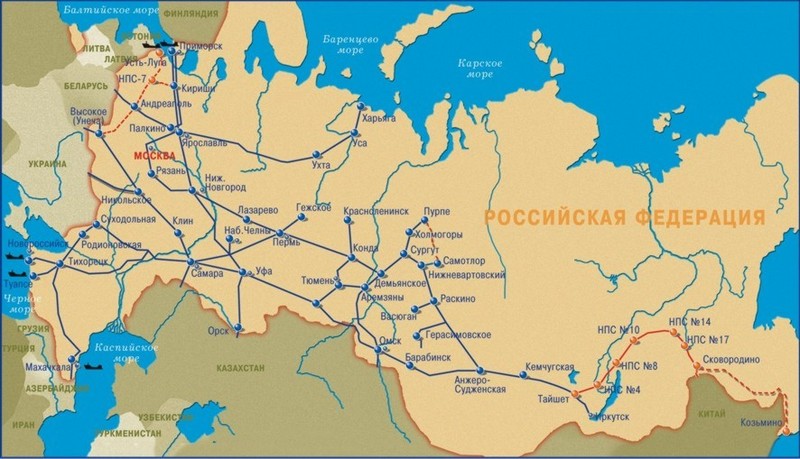
- Druzhba (Eastern Europe): 3,900 km in Russia, 8,900 km with all branches.
- Tuymazy - Irkutsk: 3,662 km.
- Uzen - Samara (Kazakhstan, Russia): 1 750 km.
- Nizhnevartovsk - Samara: 2 150 km.
- Kolmogory - Klin: 2,430 km.
- Caspian Pipeline Consortium (Kazakhstan - Russia): 1,500 km.
- Ust-Balyk - Omsk: 964 km.
- Grozny - Tuapse: 618 km.
- Surgut - Polotsk (Russia, Belarus): 3,250 km.
Although most of the pipelines were built under the USSR, Russian oil engineers are not sitting idle. Today, a number of major transport projects are being implemented to deliver crude oil to China (the Vostochny project) and Northern Europe (the Baltic Pipeline System).The BPS-2 project will significantly increase the supply of hydrocarbons to the north and reduce the load on the Druzhba pipeline. Agreements are also being implemented with Asian partners, in particular Azerbaijan and Kazakhstan.
There are ambitious plans for the development of offshore deposits of the Arctic Ocean. The Varandey oil tanker terminal is already operating in the Nenets Autonomous Okrug. In the distant future, it is planned to create robotic oil production complexes, including underwater ones. At least, such dream plans were voiced by the Chairman of the board of the military-industrial complex and the Foundation for Advanced Research D.O. Rogozin.
The most important place in the system of oil pipelines of Transneft. The company is the main pipeline operator in Russia. It is responsible for over 50,000 km of oil and product pipelines, which is a kind of world record.
Construction and operation
The main oil pipelines are made of steel or plastic pipes with an inner diameter of 100 to 1,220 mm (4 to 48 inches). Recently, pipes with increased throughput with a diameter of 1,420 mm began to be used.
Construction consists of the following steps:
- Definition of market prospects.
- Route selection.
- Pipeline design (laying new or modernizing old).
- Obtaining approval by the responsible authorities.
- Inspection and clearing of the path.
- Route preparation: digging trenches, building tunnels, crossings, etc.
- Pipe laying.
- Installation of valves, valves, branches and other equipment.
- Pipe insulation, backfilling of trenches, arrangement of protective structures.
- Hydrostatic testing.
- Commissioning.
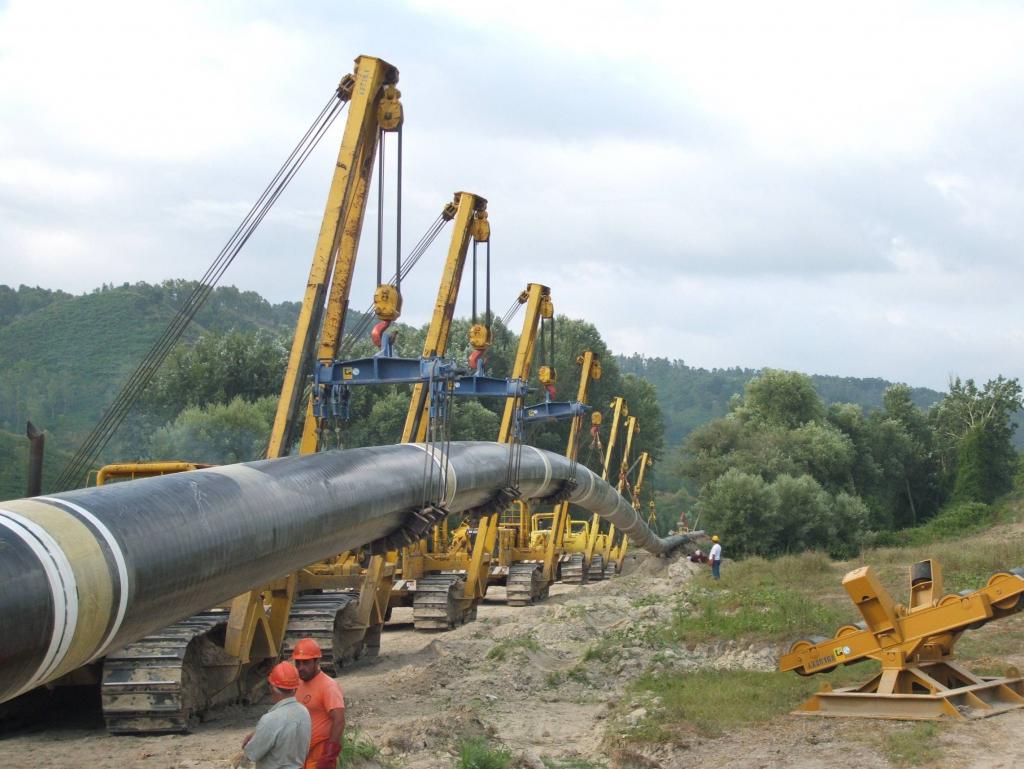
Crude oil contains a significant amount of paraffin wax. In cold climates, this substance builds up inside the pipeline. To check and clean them, mechanisms called “pigs” are used. In fact, they are “smart” brushes, additionally equipped with ultrasonic and other sensors. That is, the device simultaneously cleans the adhering wax and monitors for possible defects: leaks, corrosion, dents, thinning of the walls, cracks, etc. After finding the anomalies, the corresponding services proceed to repair the main oil pipeline.
Most pipelines are usually buried at a depth of 1 to 2 m. Various methods are used to protect the system from shock, abrasion and corrosion. These may include protective structures and compensation mechanisms made of wood, metal, rocks, high density polyethylene, soft packing and sand. Although pipes can be laid underwater, this process is economically and technically difficult, which is why most of the oil is transported by tanker ships by sea.
By the way, Russia is the only country in the world where the Pipeline Troops are created. They were formed following the results of the Great Patriotic War, when the importance of providing large military formations with fuels and lubricants became clear. Pipeline troops are trained to lay oil trunk pipelines in any conditions.
In 1941, a special unit managed to lay a 21-kilometer pipeline under the bottom of Lake Ladoga under continuous fire and duplicated an 8-kilometer pipeline along the coast. Thus, besieged Leningrad was able to get tens of thousands of tons of oil products. On behalf of Stalin, on January 14, 1952, the Pipeline Troops were formed as part of the Engineering Troops.
Control
The state of the pipelines is monitored by data collection devices. They include flow, pressure, temperature, communication systems and other elements of the measurement of the necessary data. These devices are installed along the entire route of the branch and in key places, such as injection or delivery stations, pumping stations, shut-off valves.
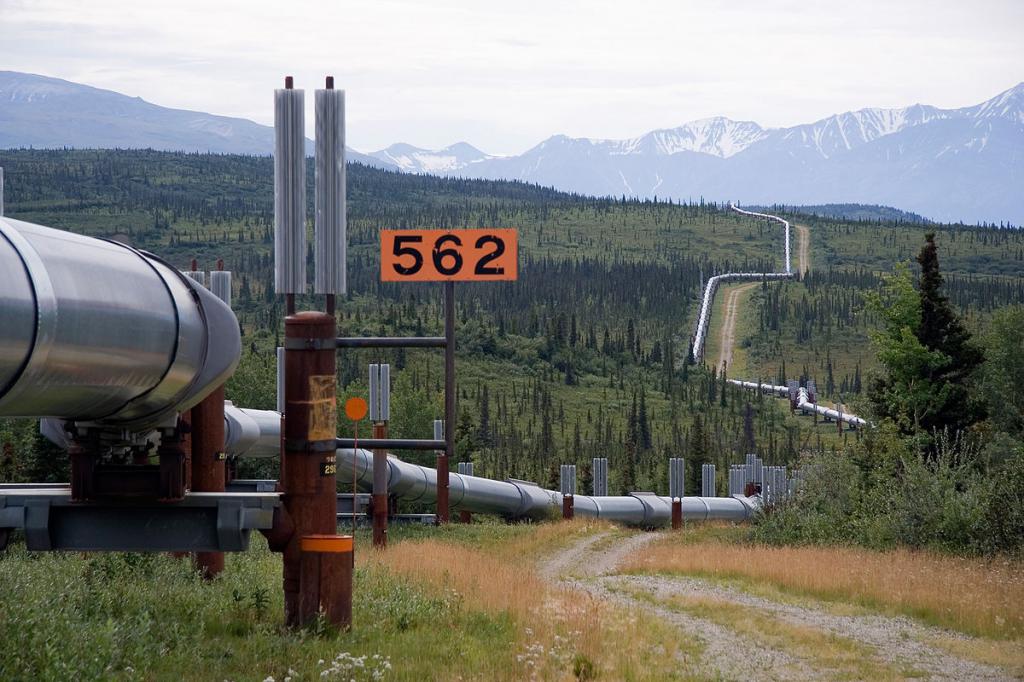
The information measured by these field tools is then collected in object communication devices (USO), which transmit sensor data to control points in real time. For this, satellite channels, microwave lines or cell phones are used.
Pipelines are remotely controlled from the main control room. In this center, all the information from the control points enters the central database. Information is received from several ODR along the chain.
Classification
Specialists distinguish several types of oil pipelines:
- trunk;
- technological;
- fishing.
In turn, trunk pipelines are divided into 4 classes, determined by the diameter of the pipes used:
- 1,000-1,420 mm;
- 500-1,000 mm;
- 300-500 mm;
- less than 300 mm.
Technological structure
The system for the transportation of hydrocarbons and their products is a complex complex. The objects of the main oil pipelines are:
- Fishing towers (stations).
- Oil gathering station.
- Inlet pipelines.
- Head structures: pumping stations, power plants, tanks and others.
- Anticorrosive installations of electrochemical protection.
- Scraper start-up unit (“pigs”).
- Linear wells.
- Items for heating raw materials.
- Technological communication lines.
- Fireproof, protective, anti-erosion facilities.
- Aqueducts, crossings under / over transport routes, rivers, straits, ravines and other obstacles.
- Emergency tanks.
- Facilities service operation.
- Telemetry and telemechanics.
- Final distribution points.
Prospects
Experts believe that further development of the global trunk pipeline system will proceed according to the following scenarios. In North America, the creation of new extended branches is not planned. First of all, this is connected with the problem of land alienation and environmental safety issues. In addition, the main oil-bearing areas are explored and developed. Changes are possible in the management of main oil pipelines, improving reliability, and automating processes.
In contrast, Europe is expected to boom in laying new branches for pumping raw materials and petroleum products. This is due to the desire to diversify supplies and reduce dependence on monopolists. Russia will not be left aside. Deposits of the northern seas, Eastern Siberia and the Far East are still waiting in the wings.
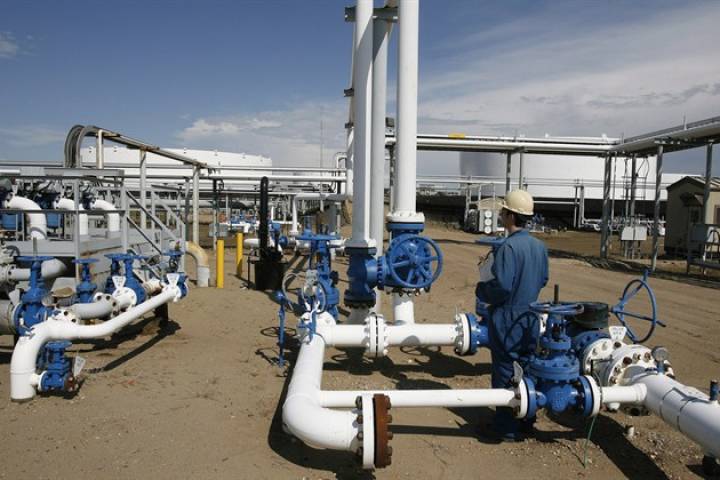
Rapid development is expected in the Asia-Pacific region. Already today 75,000 km of pipes are operated here, plans to increase this figure by 13,000 km. By the way, about 10% of oil pipelines are laid along the seabed. A number of large projects for the transportation of hydrocarbons from Western Kazakhstan and Siberia are implemented by China.
India also has a multi-kilometer pipeline network, covering from west to east the most developed northern regions of the country. The development of the transport network in the southern states seems promising. The Gulf countries have ambitious plans for the delivery of cheap oil and gas to Europe. So far, the main carriers here are tankers.
